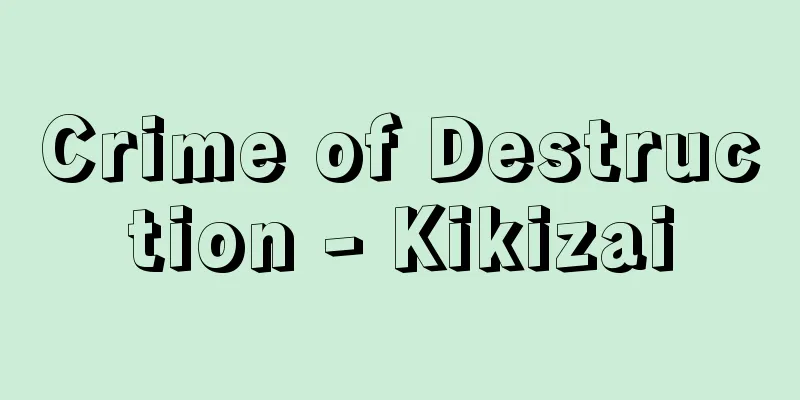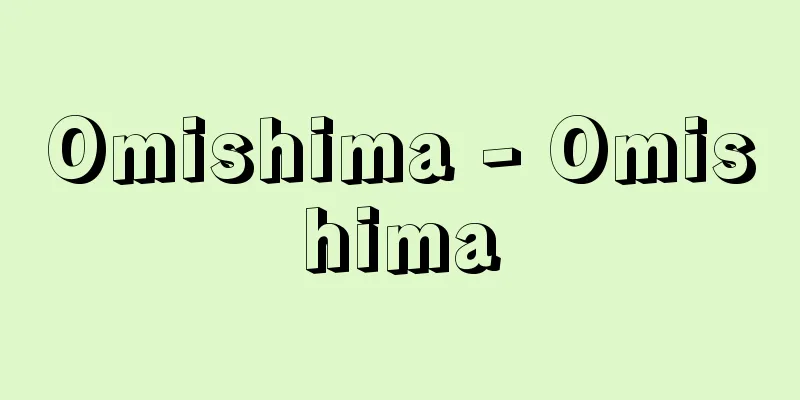Crime of Destruction - Kikizai

|
A crime that physically damages someone else's property, thereby effectively hindering the value or utility of that property itself. A type of property crime. Destruction is distinguished from so-called crimes of taking property, such as theft, robbery, fraud, and embezzlement, in that it does not harm the ownership or possession of property by others. The current Penal Code, Part 2, Chapter 40, stipulates the crimes of destruction and concealment, including destruction of official documents, destruction of private documents, destruction of buildings, destruction of property, destruction of boundaries, and concealment of correspondence (Penal Code, Articles 258 to 263). In addition, a partial revision of the Penal Code in 1987 added "electronic records" to the objects of Articles 258 and 259 as a computer crime, along with documents. In addition to "destruction," the Penal Code also uses the terms "damage," "injury," and "concealment" depending on the object of the act, but there is no difference in the content of these (however, there are different theories regarding concealment). Concerning the meaning of "destruction," the prevailing theory and precedents include any act that harms the original utility of an object, and for example, urinating into a sukiyaki pot or a sake bottle falls under this definition. As for the act of posting flyers during labor disputes, precedents have interpreted that the appearance and beauty of a building are also included in the utility of the act, and that if a large amount of flyers are posted and restoring the building to its original state is difficult, it may be considered a crime. [Tetsuro Nawa] [Reference] |Source: Shogakukan Encyclopedia Nipponica About Encyclopedia Nipponica Information | Legend |
|
他人の財物を物理的に損壊するなど、その物自体の価値・効用を事実上妨げる罪。財産罪の一種。毀棄罪は財物に対する他人の所有または占有を害しない点で、窃盗、強盗、詐欺、横領などのいわゆる領得罪と区別される。現行刑法第2編第40章は、「毀棄及び隠匿の罪」として公用文書等毀棄、私用文書等毀棄、建造物等損壊、器物損壊、境界損壊、信書隠匿の各罪を規定している(刑法258条~263条)。また、1987年(昭和62)の刑法一部改正によって、コンピュータ犯罪の一つとして、第258条および第259条の客体に、文書と並んで「電磁的記録」を追加した。なお、刑法は「毀棄」のほか、行為客体により「損壊」「傷害」「隠匿」という表現を用いているが、これらの内容に差異があるわけではない(ただ、隠匿につき異説がある)。「毀棄」などの意義について、通説・判例は物の本来の効用を害するいっさいの行為を含むものとして、たとえば飲食用のすき焼き鍋(なべ)、徳利(とっくり)に放尿するのもこれにあたると解している。なお、労働争議の際に行われるビラはり行為について、判例は建物の外観や美観もその効用に含まれるとして、大量で原状回復が困難な場合には本罪にあたりうると解している。 [名和鐵郎] [参照項目] |出典 小学館 日本大百科全書(ニッポニカ)日本大百科全書(ニッポニカ)について 情報 | 凡例 |
>>: Commissioner of the Righteous Army
Recommend
ḥalif (English spelling) halif
…But the actual group called Banu usually contain...
Under den Linden (English spelling)
... The man who put an end to this stagnation was...
Total mobilization movement for religious education
In 1929, the Ministry of Education mobilized educa...
Kawali - Kawali
...One form of this is bhajan, an expression of d...
Gardel, M.
…Later, Louis Pécourt (1653-1729) and Louis Dupré...
Gardner, A.
...These photographs allowed people to become fam...
Masamitsu Hoshina
1561-1631 Azuchi-Toyotomi - A daimyo in the early...
Uji no Kami - Uji no Kami
The head of an ancient Japanese clan. Also known a...
Shiden
One of the land categories in the land system und...
Cosmic Presence - Uchuu Sonzaido
...Chemical analysis of Earth's materials is ...
Historical materialism - historischer Materialismus German
This refers to the materialistic view of history ...
Sodium Bicarbonate - Sodium Tansansulfate
NaHCO 3 (84.01). It is also called baking soda, a...
One house in front
〘Noun〙 In the Edo period, a farming family was the...
Penicillium citrinum (English spelling) Penicilliumcitrinum
…[Takeo Shinjiro]. … *Some of the terminology tha...
Tomioka Tessai
A great modern Japanese painter. Born on December...



![Makubetsu [town] - Makubetsu](/upload/images/67cce3fa8710f.webp)





